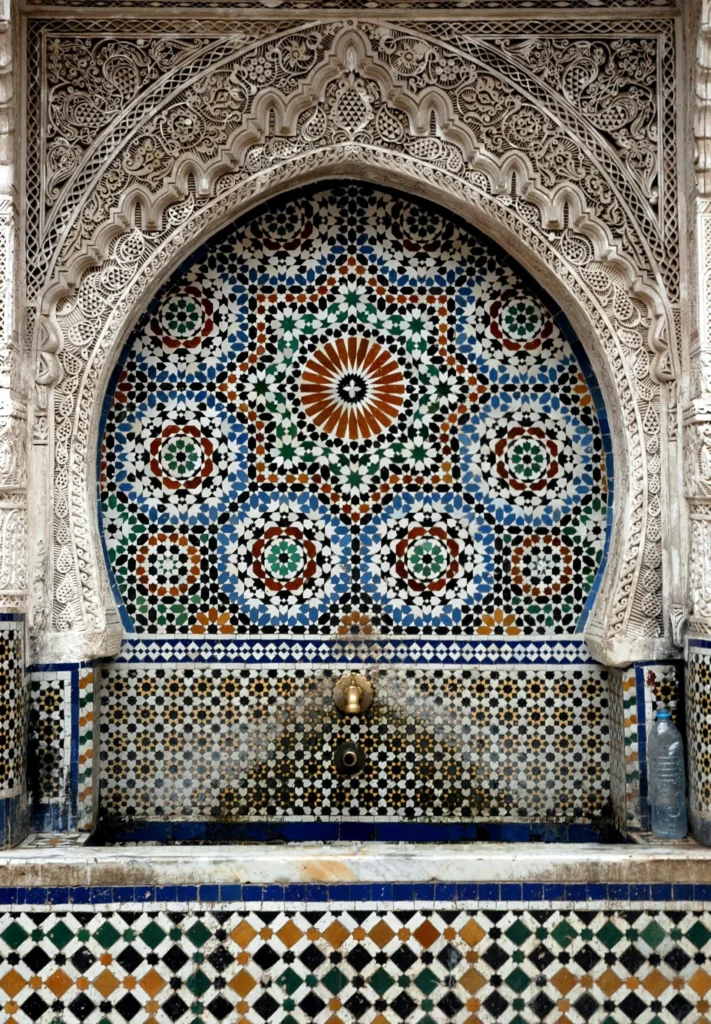
Morocco’s architectural heritage shines brilliantly through its zellige moroccan tile, capturing centuries of artistic excellence in every intricate piece. These handcrafted ceramic treasures transform ordinary spaces into stunning visual symphonies, weaving together tradition, technique, and timeless beauty. Today, zellige moroccan tile continues to captivate designers and homeowners worldwide, bringing Morocco’s rich cultural legacy into contemporary spaces.
The Rich Heritage of Zellige Moroccan Tile
The story of zellige moroccan tile begins in the 10th century during the Islamic Golden Age. Derived from the Arabic word “zillij,” meaning polished stone, these masterpieces first adorned the grand mosques and palaces of Morocco. Master craftsmen developed the art during the Almoravid and Almohad dynasties, between the 11th and 13th centuries, creating increasingly sophisticated designs that reflected Islamic artistic principles.
Each zellige moroccan tile tells a story of cultural fusion, blending Berber, Arab, and Andalusian influences. The geometric patterns speak to Islamic artistic traditions, while the vibrant colors reflect Morocco’s natural landscape. This artistic evolution continues today, as modern artisans honor ancient techniques while embracing contemporary design sensibilities.
Zellige moroccan tile: The Artistry of Design
Traditional zellige moroccan tile showcases intricate geometric patterns that create mesmerizing visual effects. Master craftsmen arrange simple shapes into complex designs that symbolize infinity and divine perfection. These patterns flow seamlessly across surfaces, transforming walls, floors, and fountains into works of art.
Beyond geometry, zellige moroccan tile often features elegant floral motifs and calligraphy. Artisans carefully select colors to convey specific meanings and emotions. Deep blues evoke tranquility and spirituality, while warm reds and yellows capture the energy of Morocco’s sun-drenched landscapes. The characteristic glossy finish enhances these colors, bringing depth and vibrancy to every installation.
Regional Masters of the Craft
Different regions of Morocco have developed distinctive approaches to zellige moroccan tile creation. Fes stands as the heart of traditional tile-making, where generations of artisans create exceptionally intricate designs. Marrakech’s workshops produce bold, dramatic pieces that command attention in grand spaces. Rabat’s craftsmen embrace a more contemporary aesthetic, while Essaouira’s artisans draw inspiration from their coastal surroundings.
Zellige moroccan tile: The Art of Creation
Creating zellige moroccan tile demands extraordinary skill and patience. Master craftsmen begin with carefully selected clay, which they shape by hand into precise forms. The sun plays its part in the process, naturally drying each piece before the first firing. Artisans then apply rich glazes using centuries-old techniques, creating the signature colors that make each zellige moroccan tile unique.
The firing process requires expert judgment, as craftsmen must achieve the perfect temperature to ensure durability without compromising the delicate glazes. After firing, skilled artisans cut and shape individual pieces, fitting them together like puzzle pieces to create magnificent patterns.

Modern Applications and Global Appeal
Today’s interior designers and architects increasingly recognize the versatility of moroccan tile. These timeless pieces bring character to modern spaces, from luxury hotels to contemporary homes. Their handcrafted nature ensures that no two installations look exactly alike, creating truly unique environments.
The enduring appeal of zellige moroccan tile lies in its ability to bridge past and present. Modern applications range from traditional mosaic patterns to innovative contemporary designs. The tiles work beautifully in various settings, from bathrooms and kitchens to dramatic feature walls and outdoor spaces.
Preserving an Ancient Art
As global demand for zellige moroccan tile grows, a new generation of artisans works to preserve this precious craft. Master craftsmen pass down their knowledge through careful apprenticeship, ensuring that traditional techniques survive in an increasingly mechanized world. This commitment to authenticity maintains the superior quality and unique character that makes zellige moroccan tile so special.
The Future of Tradition
The story of zellige moroccan tile continues to evolve. While rooted in centuries of tradition, contemporary artisans explore new possibilities within this ancient art form. They experiment with modern color palettes and innovative applications while maintaining the core techniques that give these tiles their distinctive character.
As we look to the future, zellige moroccan tile stands as a testament to the enduring power of handcrafted beauty. Each piece celebrates the marriage of artistic vision and technical mastery, ensuring that this magnificent tradition will continue to enhance spaces and inspire admirers for generations to come.
More about moroccan handicrafts https://handes.net/morocco-ancient-pottery-the-best-timeless-tradition-and-cultural-legacy/
Zellige moroccan tile :Production and Export
The production of zellige moroccan tile exemplifies centuries-old craftsmanship, with master artisans meticulously handling every step of creation. The process begins with carefully selected clay from Morocco’s rich quarries, which craftsmen knead and shape by hand into precise forms. After natural sun-drying, artisans fire each tile in traditional kilns before applying vibrant glazes made from natural pigments. These glazes create the signature colors that make each zellige moroccan tile unique, from deep Mediterranean blues to warm desert reds.
Geometric patterns
Master craftsmen then undertake the demanding process of cutting and shaping individual pieces, often as small as a fingernail, fitting them together with remarkable precision to create intricate geometric patterns. This labor-intensive process typically requires months of training to master even basic techniques, with many artisans spending years perfecting their craft.
The global market for zellige moroccan tile has expanded significantly in recent years, with exports reaching new heights as international designers and architects embrace these handcrafted treasures. Major design markets in Europe, North America, and Asia now regularly import these tiles for luxury residences, boutique hotels, and high-end commercial spaces.
zellige moroccan tile :global demand
Moroccan manufacturers have adapted to meet this growing demand while maintaining traditional production methods, establishing relationships with international distributors and design firms. However, authentic zellige moroccan tile commands premium prices due to its handcrafted nature and limited production capacity, as each piece requires significant time and skill to create. This combination of increasing global demand and artisanal production has led to a thriving export market that both preserves traditional craftsmanship and brings Morocco’s architectural heritage to a worldwide audience.


